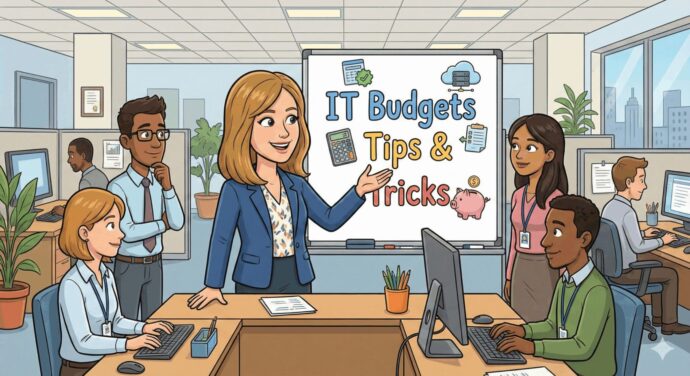IT Lifecycle Management
Information technology is critical to your business, without which your business cannot function. The software, hardware, network, and other technologies that support your business operations make up the assets that support business operations. IT assets are numerous, and besides, they are expensive to acquire, configure, and maintain. Since IT assets are frequently moved, they depreciate quickly and require regular updating and replacement.
As an IT asset manager, it’s crucial to understand the lifecycle stages of your assets. Their lifecycle begins from the time you acquire them and ends at the point when you dispose of them. The lifecycle includes the depreciation adjustments, repairs, and upgrades performed on an asset.
Every piece of technology equipment you purchase will always come to its “end of life.” At this point, it slows down and performs poorly, presenting issues and frustrations to your business.
For proper planning and minimal business disruptions, you don’t need to wait until the time when technology is no longer helpful to replace it. Doing so only increases inconveniences and doesn’t allow you enough time for planning and replacement. That is where IT lifecycle management comes in to help you with the proper transition from old to new technology.

What is IT Lifecycle Management?
The IT lifecycle management process entails managing software, hardware, and infrastructure. It allows you to plan, examine your business needs, work on your budget, and acquire new technology in good time. An effective IT asset management program delivers significant benefits to your business through increased agility, IT cost management, and reduced risk.
The definition of IT lifecycle management highlights four essential elements that help your business realize the value of asset management:
- Reliably creates systems in a scalable and automated manner
- Ensures system consistency across the lifecycle of the IT assets
- Tracks and accounts for all your systems, purchases, and subscriptions
- Decommissions systems and resources when you no longer need them
With a good IT lifecycle management program, you will be in a better position to:
- Forecast your IT needs with more precision
- Make informed decisions when purchasing new IT assets
- Be more proactive in replenishing your technology resources
- Improve the quality of your IT services
- Know the total cost of IT asset ownership
The Stages of IT Lifecycle Management
Your IT lifecycle management team plays a role in tracking the changes in technology assets, their configuration, and location. Every technology, big or small, undergoes five critical stages in the asset management lifecycle:
1. Procurement
Procurement marks the first stage in maintaining your IT asset lifecycle and is the actual purchasing of the asset. For every IT asset your business needs, there will always be various options to choose from, but the decision you make should fulfill your company’s requirements without exceeding the budget. Before making a purchasing decision, it’s essential to identify the business needs based on the gathered data. You should then make forecasts to justify the actual purchase.
The procurement process entails:
- Creating purchase orders
- Predefining the Purchase Order workflow
- Linking to cost budgets
- Approval of the Purchase Order
- Making the purchase and adding it to the inventory
2. Deployment
At this stage, some crucial actions take place before the purchased asset is put into use. Deployment entails assembling the asset and conducting preliminary checks to identify any physical defects and engineering problems. It also calls for:
- Checking the design and if the purchase is safely and correctly installed
- Changing the status of the asset from inventory to in-use
- Discovering the assets in the network for hardware and asset inventory
- Allocating each software to a hardware asset
- Adding relationship maps
3. Utilization
Utilization marks the longest stage in IT lifecycle management. It is the phase at which the asset is put into the use for which it was acquired. Your business starts realizing the revenue and returns on the capital.
The stage entails patch fixes, upgrade, purchasing new licenses, cost-benefit analysis, and compliance audits. It also calls for ongoing assessment of asset performance to check for issues that may occur unexpectedly. The primary area of focus during the utilization stage is to get the most returns from the asset. The stage entails:
- Monitoring and scheduling scans
- License management
- Complete ownership tracking
- Financial management
- Backup
4. Maintenance
As you continue to use your IT assets, they will be subjected to wear and tear, which is why maintenance is necessary. Proper care helps prolong the lifecycle of your IT assets and entails modifications and upgrades to sync the asset for faster and better performance. Maintenance entails:
- Notification of expiry dates to the technicians
- Keeping up to date with software license agreements linked to the software
- Identifying impact through dependency mapping
- Maintaining contracts for the assets
5. Disposal or Decommissioning
At the end of an asset’s productive life, it has to be disposed of, but the service deliverables should inform the decision to remove an asset. Ensure you check, treat, sanitize, or process all part of the assets to avoid harming nature or society when disposing of the item.
Additionally, ensure you wipe off all data from the IT asset and dismantle it piece by piece. The recyclable parts should be sent to recycling plants. The process also entails:
- Changing the status of an asset to disposed or expired
- Removing the software allocations to the disposed asset
Dangers of Not Having an IT Lifecycle Management Plan
When your IT assets are not performing at their best, and they are not correctly managed, your business risks running into several issues:
- Increased costs in maintaining the old assets: maintaining old IT assets can be costlier than replacing them.
- Security breaches: if your IT infrastructure is not updated, it can create vulnerabilities that expose you to attacks.
- Low productivity and employee morale: latency and poor technology performance affect employee morale, affect productivity, and lead to high employee turnover.
Final Thoughts
Replacing old technology assets can be a daunting task, but it has to be done. If you have a proper IT lifecycle management system, the process doesn’t have to be haphazard and should not disrupt your budget. The program gives you the time to plan and schedule IT asset replacement. Remember that the consequences of not upgrading your technology are far worse than meeting the cost of replacement.
If you don’t have an IT lifecycle management plan in place, it’s high time to create one. The good news is that you don’t have to do it alone. Experts at Essential Solutions can help you. Contact us today to schedule an initial consultation on IT lifecycle management for your business.



